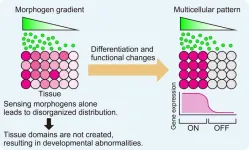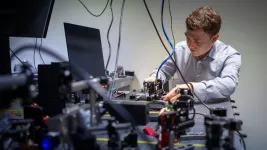(Press-News.org) A new study published in the Proceedings of the National Academy of Sciences (PNAS) challenges long-held assumptions about human cooperation. Traditionally, behavioral scientists and economists have primarily studied cooperation in public good contexts through repeated interactions, where individuals can build trust and reciprocal relationships, adjusting their behavior based on the actions of others. However, many real-world, naturally occurring situations, such as volunteering or donating to crisis relief efforts, are one-time decisions with no obvious future interactions or relationships to consider. This new study, co-authored by Dr. Natalie Struwe and Prof. Esther Blanco from the University of Innsbruck with Prof. James Walker from Indiana University, explored how individuals cooperate when they only have one opportunity to cooperate in a social group, not knowing the identity of other group members.
Two large-scale experiments
Across two experiments involving over 2,000 participants, the researchers varied the potential benefits from cooperation in public good provision. Despite the increased benefits for cooperating, the study found no significant change in how much individuals were willing to cooperate. The mechanism behind this behavior seems to lie in individuals' expectations of others’ willingness to cooperate which were also not found to vary with the benefits of cooperating. As participants did not expect others to cooperate more when benefits increased, they were unlikely to increase their own cooperation efforts—even when the benefits of cooperation doubled.
"Our findings highlight a critical gap in our understanding of cooperative behavior in single-encounter settings," said Dr. Natalie Struwe of the Department of Public Finance at the University of Innsbruck. "The decision to cooperate is characterized by what we call a social dilemma. These are situations where self-interest is in conflict with social interests. With higher benefits from cooperation, however, this conflict is much lower and we would expect to see much higher cooperation rates. But, we were surprised to see that even when we dramatically increased the benefits from cooperation, people’s cooperation efforts did not rise accordingly. This suggests that real-world cooperation—such as donating to immediate disaster relief—may not always be driven by an assessment of increased benefits."
Consistent results across data collections
“We couldn’t believe the results ourselves at first, double-checked the data several times, and repeated the study with several populations,“ said Professor Esther Blanco of the Department of Public Finance at the University of Innsbruck. “In the end, we gathered nearly 2,000 data points, conducting experiments online with the general population from the UK, as well as with our students—both online and in our laboratory. No matter what we did, the results remained consistent: cooperation levels were remarkably stable. The general public was no more or less cooperative than our students. On average, participants were willing to invest around 40% of their available money to boost their group’s earnings, regardless of the specific setting."
"Spontaneous cooperation in one-time situations is more common than we might think," Professor James Walker, another of the co-authors, at the Department of Economics of Indiana University, explained. "For example, people coming together to provide immediate disaster relief is a case of one-time cooperation, where individuals decide to act and help without knowing whether they will interact with the same people again."
The study's results have important implications for how we think about encouraging cooperation in public good provision, especially in urgent, one-time scenarios like disaster relief or emergency volunteering. It also points to the need to better understand the fundamentals of cooperative behavior, one of the most defining characteristics of humankind.
Key Findings:
Individuals do not significantly change their contributions to public goods when the benefits from cooperation increase, in contrast to previous research in repeated interactions.
Expectations about others’ contributions strongly influence individual behavior in one-time settings and do not vary significantly with changes in benefits from cooperation.
Average cooperation levels remained consistently around 40% across different participant groups and experimental settings, including both the general public and university students.
The study underscores the need for further research into cooperation in one-time decision settings, in particular how individuals interpret the benefits and respond in such settings, as well as how they expect others to respond.
This research opens new avenues for exploring how to effectively foster cooperation in critical single encounter situations and calls for a deeper understanding of the psychological and social factors at play.
Paper:
Natalie Struwe, Esther Blanco, James M. Walker: Increasing benefits in one-time public goods does not promote cooperation, Proceedings of the National Academy of Sciences 2024, Vol. 121, No 41, DOI: 10.1073/pnas.2410326121, https://www.pnas.org/doi/abs/10.1073/pnas.2410326121
END
Study: One-time cooperation decisions unaffected by increased benefits to society
2024-10-08
ELSE PRESS RELEASES FROM THIS DATE:
Soil volatile organic compound profiles as indicators for soil evaluation in soybean fields
2024-10-08
Tsukuba, Japan—Maintaining soil health is crucial for sustainable agriculture. Recently, soil volatile organic compounds (VOCs) have emerged as promising indicators for assessing soil health. This study aimed to evaluate the effectiveness of soil VOC profiles as indicators of soil health in soybean fields.
Soil samples were collected from soybean fields in Fukushima Prefecture, which exhibited diverse soil conditions, over the past three years. These samples were analyzed for VOC content in conjunction with data on soil physical properties, soil metabolome, soil ionome, and soil microbiome as well as rhizosphere chemicals ...
Shedding light on how tissues grow with sharply defined structures
2024-10-08
Researchers at Nano Life Science Institute (WPI-NanoLSI), Kanazawa University, demonstrate how morphogens combined with cell adhesion can generate tissue domains with a sharp boundary in an in vitro model system.
Recent advances that have enabled the growth of tissue cultures into organoids and embryoids have heightened interest as to how tissue growth is controlled during the natural processes of embryo development. It is known that the diffusion of signaling molecules called morphogens directs patterned tissue growth ...
JAMA Network launches JAMA+ AI
2024-10-08
October 8, 2024 (Chicago) — The JAMA Network today announces the launch of JAMA+ AI, an engaging, interactive channel that amplifies the best of the JAMA Network’s content exploring the science of artificial intelligence and digital medicine and its application in health and health care.
JAMA+ AI is a window into the premier scientific content, educational reviews, and commentary on AI and medicine published across JAMA, JAMA Network Open, and the 11 JAMA specialty journals. JAMA+ AI builds on that content with new multimedia materials, including interviews ...
Climate report warns of escalating crisis, urges immediate action as UN summit nears
2024-10-08
CORVALLIS, Ore. – An international coalition led by Oregon State University scientists concludes in its annual report published today that the Earth’s worsening vital signs indicate a “critical and unpredictable new phase of the climate crisis” and that “decisive action is needed, and fast.”
The collaboration directed by OSU’s William Ripple and former postdoctoral researcher Christopher Wolf outlines areas where policy change is needed – energy, pollutants, nature, food and economy – in “The 2024 State of the Climate Report: Perilous Times on Planet Earth,” published ...
Scientists issue urgent warning on climate emergency
2024-10-08
A new report published in BioScience warns that the world is facing a climate emergency of unprecedented magnitude. The "2024 State of the Climate Report," by an international team of scientists led by Oregon State University's William Ripple and Christopher Wolf, presents alarming evidence that climate change is worsening at a dangerous pace.
In the report, the authors update 35 annually reported "planetary vital signs," which provide ongoing timeseries of human climate-related activities ...
First successful demonstration of a dual-media NV diamond laser system
2024-10-08
Measuring tiny magnetic fields, such as those generated by brain waves, enables many new novel opportunities for medical diagnostics and treatment. The research team led by Dr. Jan Jeske at Fraunhofer IAF is working on a globally innovative approach to precise magnetic field measurements: Laser Threshold Magnetometry. The researchers have now combined an NV diamond and a laser diode in a resonator, successfully demonstrating the sensor system with two active media for the first time. This outstanding paper has been published in Science Advances and represents a significant progress in the BMBF-funded research project NeuroQ.
Quantum ...
A call to bridge the gap in cancer clinical trial funding
2024-10-08
CHAPEL HILL, North Carolina — A growing reliance on industry-sponsored cancer clinical trials in the United States is a reason for concern, say researchers from the UNC Lineberger Comprehensive Cancer Center.
In a Journal of Clinical Oncology editorial, Yara Abdou, MD, and Norman E. Sharpless, MD, responded to a new study by the Fred Hutchinson Cancer Center in Seattle that found enrollment in industry-sponsored cancer clinical trials doubled between 2008 and 2022 while federally supported trial enrollment remained flat. From 2018 to 2022, cancer clinical trial enrollment was eight times greater in industry-sponsored studies compared to federal studies.
Abdou and Sharpless called ...
Despite heavy marketing, most Americans reject the new weight-loss drugs
2024-10-08
Washington, D.C. — A new national survey shows that, despite intense marketing, most Americans do not want the new weight-loss injectables, such as Wegovy and Ozempic. The survey was conducted by Morning Consult for the Physicians Committee for Responsible Medicine, a non-profit organization with more than 17,000 physician members, on Sept. 5, 2024, and included 2,205 adults.
Asked to respond to the statement, “If I wanted to lose weight, I would rather take an injectable weight-loss drug, rather than make a diet change,” only 23% agreed or strongly agreed, while 62% disagreed or strongly disagreed and another 14% said they were not ...
Ochsner Children’s Hospital named No.1 hospital for kids in Louisiana for fourth consecutive year
2024-10-08
NEW ORLEANS – For the fourth year running, Ochsner Children’s Hospital upholds its position as the No. 1 hospital for kids in Louisiana according to the 2024-2025 Best Children’s Hospital rankings by U.S. News & World Report. Ochsner Children’s Hospital continues to shine nationally with Top 50 rankings in three specialties: pediatric cardiology and heart surgery, pediatric gastroenterology and gastrointestinal surgery and pediatric orthopedics. This prestigious recognition marks eight consecutive years on the ranking list, a unique achievement ...
Rates of a tick-borne parasitic disease are on the rise
2024-10-08
HERSHEY, Pa. — Rates of babesiosis, a tick-borne parasitic disease, increased an average of 9% per year in the United States between 2015 and 2022 and four in 10 patients were found to be co-infected with another tick-borne illness such as Lyme disease, according to a new study led by researchers at Penn State Health Milton S. Hershey Medical Center and Penn State College of Medicine.
“These findings suggest that clinicians should have a heightened vigilance of co-infection of other tick-borne illness among patients admitted with babesiosis,” said Paddy Ssentongo, infectious disease fellow, Penn State Health Milton S. Hershey Medical Center and lead author of the study. ...


